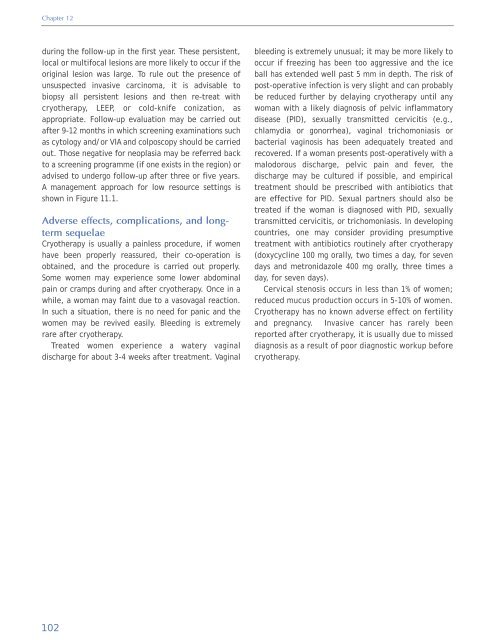Colposcopy and Treatment of Cervical Intraepithelial Neoplasia - RHO
Colposcopy and Treatment of Cervical Intraepithelial Neoplasia - RHO
Colposcopy and Treatment of Cervical Intraepithelial Neoplasia - RHO
You also want an ePaper? Increase the reach of your titles
YUMPU automatically turns print PDFs into web optimized ePapers that Google loves.
Chapter 12<br />
during the follow-up in the first year. These persistent,<br />
local or multifocal lesions are more likely to occur if the<br />
original lesion was large. To rule out the presence <strong>of</strong><br />
unsuspected invasive carcinoma, it is advisable to<br />
biopsy all persistent lesions <strong>and</strong> then re-treat with<br />
cryotherapy, LEEP, or cold-knife conization, as<br />
appropriate. Follow-up evaluation may be carried out<br />
after 9-12 months in which screening examinations such<br />
as cytology <strong>and</strong>/or VIA <strong>and</strong> colposcopy should be carried<br />
out. Those negative for neoplasia may be referred back<br />
to a screening programme (if one exists in the region) or<br />
advised to undergo follow-up after three or five years.<br />
A management approach for low resource settings is<br />
shown in Figure 11.1.<br />
Adverse effects, complications, <strong>and</strong> longterm<br />
sequelae<br />
Cryotherapy is usually a painless procedure, if women<br />
have been properly reassured, their co-operation is<br />
obtained, <strong>and</strong> the procedure is carried out properly.<br />
Some women may experience some lower abdominal<br />
pain or cramps during <strong>and</strong> after cryotherapy. Once in a<br />
while, a woman may faint due to a vasovagal reaction.<br />
In such a situation, there is no need for panic <strong>and</strong> the<br />
women may be revived easily. Bleeding is extremely<br />
rare after cryotherapy.<br />
Treated women experience a watery vaginal<br />
discharge for about 3-4 weeks after treatment. Vaginal<br />
bleeding is extremely unusual; it may be more likely to<br />
occur if freezing has been too aggressive <strong>and</strong> the ice<br />
ball has extended well past 5 mm in depth. The risk <strong>of</strong><br />
post-operative infection is very slight <strong>and</strong> can probably<br />
be reduced further by delaying cryotherapy until any<br />
woman with a likely diagnosis <strong>of</strong> pelvic inflammatory<br />
disease (PID), sexually transmitted cervicitis (e.g.,<br />
chlamydia or gonorrhea), vaginal trichomoniasis or<br />
bacterial vaginosis has been adequately treated <strong>and</strong><br />
recovered. If a woman presents post-operatively with a<br />
malodorous discharge, pelvic pain <strong>and</strong> fever, the<br />
discharge may be cultured if possible, <strong>and</strong> empirical<br />
treatment should be prescribed with antibiotics that<br />
are effective for PID. Sexual partners should also be<br />
treated if the woman is diagnosed with PID, sexually<br />
transmitted cervicitis, or trichomoniasis. In developing<br />
countries, one may consider providing presumptive<br />
treatment with antibiotics routinely after cryotherapy<br />
(doxycycline 100 mg orally, two times a day, for seven<br />
days <strong>and</strong> metronidazole 400 mg orally, three times a<br />
day, for seven days).<br />
<strong>Cervical</strong> stenosis occurs in less than 1% <strong>of</strong> women;<br />
reduced mucus production occurs in 5-10% <strong>of</strong> women.<br />
Cryotherapy has no known adverse effect on fertility<br />
<strong>and</strong> pregnancy. Invasive cancer has rarely been<br />
reported after cryotherapy, it is usually due to missed<br />
diagnosis as a result <strong>of</strong> poor diagnostic workup before<br />
cryotherapy.<br />
102
















